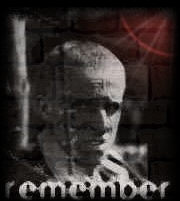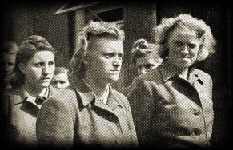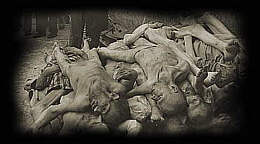Bergen-Belsen (original) (raw)



In April 1943 the Nazis created Bergen-Belsen in Lower Saxony near the city of Celle as a transit center - Bergen-Belsen was never officially given formal concentration camp status. But the second commandant, SS-Hauptsturmf�hrer Josef Kramer, completed the transformation of Bergen-Belsen into a regular concentration camp.
By 1945 thousands of prisoners who had become too weak to work were shipped there, to die off slowly by starvation and typhoid. In the one month of March, more than 18,000 succumbed.
The first commandant in Bergen-Belsen was SS-Hauptsturmf�hrer Adolf Haas. His previous assignment had been the concentration camp known as Niederhagen/Wewelsburg near Paderborn. In early 1944, Haas was replaced by SS-Hauptsturmf�hrer Josef Kramer who had been working in concentration camps since 1934.
Josef Kramer`s most recent assignment had been at the death camp Auschwitz-Birkenau. His incumbency had earned him the nickname the Beast of Belsen.


Josef Kramer
His prescription for the uncontrollable epidemic of diarrhea was starvation. 'If you don't eat, you don't shit.' When railroad cars and convoys were unavailable, he dispatched the prisoners on long marches. The weakest, unable to keep going, were left to die or were shot. The roads were littered with thousands who had succumbed ...
In her book Five Chimneys the Holocaust survivor Olga Lengyel later recalled the SS troops in fits of destructive insanity, blindly beating the sick women, kicking the pregnant: 'Kramer himself had lost his calm. A strange gleam lurked in his small eyes, and he worked like a madman. I saw hin throw himself at one unfortunate woman and with a single stroke of his truncheon shatter her skull ..'

A Bergen-Belsen survivor, Fania Fenelon, provides this grim vignette just prior to the discovery of the camp at Bergen-Belson, with the war nearly at an end:
The stench had become intolerable; wrapped in my cloak, a priceless possession, I went out in search of air, to stretch out, to sleep in the open. The ground was muddy and cold, so I kept walking. In front of me, a pile of corpses balanced carefully on one another, rose geometrically like a haystack. There was no more room in the crematoria so they piled up the corpses out here.
I climbed up them as one would a slope; at the top I stretched out and fell asleep. Sometimes an arm or leg slackened to take its final position. I slept on; in the morning, when I woke up, I thought I that I too must be losing my reason ...
Fania Fenelon weighed 65 pounds the day the British arrived...
Another prisoner, Moshe Peer, now 67, was held captive as a boy at the Bergen-Belsen concentration camp during World War II. In 1942, at age 9, Peer and his younger brother and sister were arrested by police in their homeland of France.
His mother was sent to Auschwitz and never returned. Peer and his siblings were sent to Bergen-Belsen two years later.
Moshe Peer has spent many years writing a first-person account of the horror he witnessed at Bergen-Belsen. He recalls the separation from his parents as excruciating. But surviving the horrors of the camp quickly became a priority: `There were pieces of corpses lying around and there were bodies lying there, some alive and some dead,` Peer recalled, `Bergen-Belsen was worse than Auschwitz because there people were gassed right away so they didn't suffer a long time ...` Russian prisoners were kept in an open-air camp and were given no food or water. `Some people went mad with hunger and turned to cannibalism.`
MoshePeer and his siblings - who all survived - were cared for at the camp by two women, whom Peer unsuccessfully tried to find after the war. Peer was reunited with his father in Paris and the family moved to Israel. Peer's four children were born in Israel, but after serving in the Israeli army in a number of wars, Peer moved to Montreal in 1974. Even today 55 years later, Peer is still haunted by his concentration-camp experience and still finds his memories keep him awake at night.
Hitlers most famous victim Anne Frank ended up in Bergen-Belsen after being evacuated from Auschwitz in October, 1944. As starvation. cold and disease swept through the camp's population, Margot, Anne's sister, developed typhus and died. A few days later, Anne herself, in April, 1945, succumbed to the disease a few weeks before the camp was liberated by the British. She was 15 years old ...
At the same time this little boy miraculously survived the same camp, Bergen-Belsen! More than any other photos, this famous photograph captures the essence of the horrors of Holocaust: Warsaw 1943, a little Jewish boy dressed in short trousers and a cap, raises his arms in surrender with lowered eyes, as a Nazi soldier trains his machine gun on him.
The photograph goes right to the heart, and after the war millions of people were brought to believe that the frightened little boy was murdered like Anne Frank and millions of other Jews.
By a miracle the boy survived, and he was found after several decades - Tsvi C. Nussbaum, a physician living in Rockland County in upstate New York, USA.

Bergen-BelsenSS-women. On the right the notorious Herta Bothe, after the war charged with having committed war crimes. She had a good time shooting at weak female prisoners carrying food containers from the kitchen to the block with her pistol. And she often beat sick girls with a wooden stick. At the Bergen-Belsen Trial she got imprisonment for 10 years.
On April 15, 1945, the British army liberated Belsen. However, it was unable to rescue the inmates. On that liberation day the British found 10,000 unburied corpses and 40,000 sick and dying prisoners. Among the 40,000 living inmates, 28,000 died after the liberation. The inmates were abandoned in Bergen-Belsen by the Germans, left behind for death to come.
Between April 11 and 14, 1945, two thousand prisoners had to drag the dead to huge mass graves ...
Captured by the British after liberation, SS Hauptsturmf�hrer Josef Kramerwas arrested, tried, and later executed.
Abram L. Sachar. The Redemption Of The Unwanted. New York: St. Martin's/Marek, 1983.
Fania Fenelon with Marcelle Routier. Playing For Time. New York: Athenium, 1977.
The Montreal Gazette, Montreal, Canada, August 5, 1993
� 2012-14 Louis B�low. All Rights Reserved.
